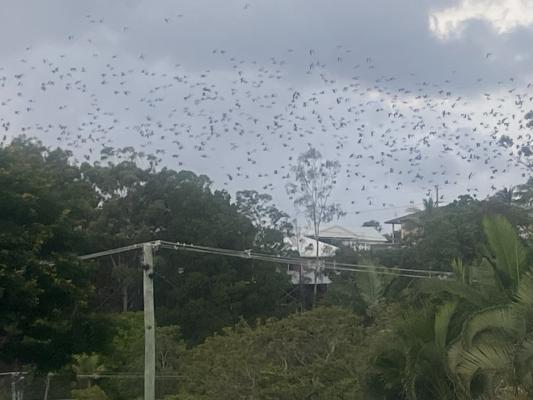By Arthur Gorrie
Direct action against Cooloola’s near-residential flying fox colonies, has been deemed illegal, immoral and potentially worse than useless.
A council staff report last week listed potentially problematic roosting sites at Queen Elizabeth Drive at Cooloola Cove, Snapper Point at Tin Can Bay and in the hinterland, Power St, Neerdie, as well as Gympie city’s better known human conflict area at Commisisoner’s Gully.
The Neerdie location has already prompted serious concerns from residents, some of whom have been especially worried about the disease potential from bat droppings on the roofs from which they gather their drinking water.
Less likely to conflict with urban residents was the one known site at Inskip Reserve, but the potential for concerns from holiday makers at nearby government-run Inskip Point camping areas remains a serious source of doubt.
Other sites less likely to impact on concentrated human settlement include Anderleigh Rd Goomboorian, Beenham Valley Rd Beenham Valley, Amamoor State Forest Amamoor and Hyne Estate Rd Kandanga.
Councillors at an open briefing were told dispersal via roost disruption should be seen as a last resort, because of possible conflict with state and federal laws, cost and the real risk that the bats would move somewhere else just as bad, or possibly split and re-establish roosts in several other locations (thus making the problem worse).
“The community should be aware that activities that result in disturbance of flying fox camps can result in breaches of the (state) Nature Conservation Act, the Animal Care and Protection Act and the (federal) Environment Protection and Biodiversity Conservation Act,“ the report said.
Staff recommended the council concentrate on council managed land only and consider dispersal as “a last resort in extreme circumstances,“ on the grounds that it could be “costly and risky.“
The favoured solution in Gympie city seems to be rehabilitating or creating alternative roosting sites which the bats may find more attractive than their current, more problematic, roosting locations in Commissonert’s Gully, near the hospital.
The extent to which this may be possible at the Cooloola Coast is not dealt with clearly in the report, although there have been some complaints in recent years from Cooloola Cove residents.
“Dispersal of flying fox colonies is not considered at this point an appropriate management action for any known roosts within the Gympie Regional Council local government area due to high costs (and) uncertain outcomes (that is, low likelihood of success),“ the report says.
There was also “potential to splinter colonies, leading to further conflict with the community and additional operational costs..“
Breaches of state or federal laws could result in the council being investigated and even prosecuted, it said.
The open councillor workshop focused on providing information, draft policies and promoting discussion among councillors and the public.
The draft policies aim to present a mechanism “to assist council in engaging with the community and demonstrate council’s management intent.
The major policy proposal is the draft Statement of Management Intent.
Staff told councillors adoption of a Statement of Management Intent would “establish the council’s direction for managing flying fox populations“ and would provide a “platform for communicating with the community… in compliance with legislative obligations.“
What you are allowed to do:
Where flying fox roosts impact on homes, particularly where they are established close to private property, residents are still allowed to mow their lawn and undertake “weeding, mulching or minor trimming of roost trees and do not need a permit.“
However, they do have to adhere to state guidelines for “low impact activities,“ details of which are available at ’environment.des.qld.gov.au/wildlife/animals/living-with/bats/flying-foxes/roost management#toc=1’.
Management of roosts on privately owned land remains the responsibility of landowners, who can apply for a roost management permit, as is also the case if they are dissatisfied with the council’s approach.
Information on flying fox-related health concerns can be obtained from the Department of Agriculture and Fisheries or Queensland Health.
Detailed further information on flying foxes and their management can also be found on the Department of Environment and Science website.
Council policies can be found by contacting the council on 1300 307 800 or by email to ’environment@gympie.qld.gov.au’.
The three main species of flying fox in the Gympie Regional Council area are:
The grey-headed flying fox (rated “vulnerable“ nationally and “least concern“ in Queensland) is the largest Australian bat, with a wingspan up to 1m and dark grey body hair;
The black flying fox (common in near coastal areas) is about 26cm and 1kg with short black fur; and
Little Red Flying Fox (common in sclerophyll and rainforest) reddish brown or light brown and between 200g and 600g.
.


